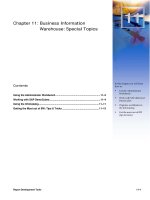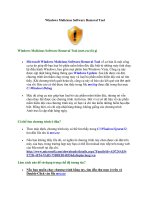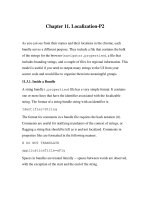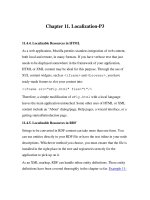Chapter+11+ malicious+ software
Bạn đang xem bản rút gọn của tài liệu. Xem và tải ngay bản đầy đủ của tài liệu tại đây (1.36 MB, 57 trang )
Cryptography and Network Security
Chapter 11
Malicious Software
Lectured by
Nguyễn Đức Thái
Outline
Types of Malicious Software
Viruses
Virus Countermeasures
Worms
Distributed Denial of Service Attacks
2
Key Points
Malicious software is software that is intentionally included
or inserted in a system for a harmful purpose.
A virus is a piece of software that can “infect” other
programs by modifying them; the modification includes a
copy of the virus program, which can then go on to infect
other programs.
A worm is a program that can replicate itself and send copies
from computer to computer across network connections.
• Upon arrival, the worm may be activated to replicate and propagate
again.
• In addition to propagation, the worm usually performs some
unwanted function.
3
Key Points
A denial of service (DoS) attack is an attempt to prevent
legitimate users of a service from using that service.
A distributed denial of service (DDOS) attack is launched from
multiple coordinated sources.
4
Intro
Perhaps the most sophisticated types of threats to computer
systems are presented by programs that exploit
vulnerabilities in computing systems.
Such threats are referred to as malicious software, or
malware.
In this context, we are concerned with threats to application
programs as well as utility programs, such as editors and
compilers, and kernel-level programs.
5
Types of Malicious Software
Malicious software can be divided into two categories:
• those that need a host program, and
• those that are independent.
The former, referred to as parasitic, are essentially fragments
of programs that cannot exist independently of some actual
application program, utility, or system program. Viruses, logic
bombs and backdoors are examples
Independent malware is a self-contained program that can be
scheduled and run by the operating system. Worms and bot
programs are examples
6
Types of Malicious Software
We can also differentiate between those software threats
that do not replicate and those that do.
The former are programs or fragments of programs that are
activated by a trigger. Examples are logic bombs, backdoors,
and bot programs.
The latter consist of either a program fragment or an
independent program that, when executed, may produce one
or more copies of itself to be activated later on the same
system or some other system. Viruses and worms are
examples.
7
Types of Malicious Software
8
Backdoor
A backdoor, also known as a trapdoor, is a secret entry point
into a program that allows someone who is aware of the
backdoor to gain access without going through the usual
security access procedures.
Programmers have used backdoors legitimately for many
years to debug and test programs; such a backdoor is called a
maintenance hook
This usually is done when the programmer is developing an
application that has an authentication procedure, or a long
setup, requiring the user to enter many different values to
run the application. To debug the program, the developer
may wish to gain special privileges or to avoid all the
necessary setup and authentication
9
Backdoor
The programmer may also want to ensure that there is a
method of activating the program should something be
wrong with the authentication procedure that is being built
into the application.
The backdoor is code that recognizes some special sequence
of input or is triggered by being run from a certain user ID or
by an unlikely sequence of events.
Backdoors become threats when unscrupulous programmers
use them to gain unauthorized access
It is difficult to implement operating system controls for
backdoors.
Security measures must focus on the program development
and software update activities.
10
Logic bomb
One of the oldest types of program threat, predating viruses
and worms, is the logic bomb.
The logic bomb is code embedded in some legitimate
program that is set to “explode” when certain conditions are
met.
Examples of conditions that can be used as triggers for a
logic bomb are the presence or absence of certain files, a
particular day of the week or date, or a particular user
running the application.
Once triggered, a bomb may alter or delete data or entire
files, cause a machine halt, or do some other damage
11
Trojan horses
A Trojan horse is a useful, or apparently useful, program or
command procedure containing hidden code that, when
invoked, performs some unwanted or harmful function.
Trojan horse programs can be used to accomplish functions
indirectly that an unauthorized user could not accomplish
directly
• For example, to gain access to the files of another user on a shared
system, a user could create a Trojan horse program that, when
executed, changes the invoking user’s file permissions so that the files
are readable by any user.
• The author could then induce users to run the program by placing it in
a common directory and naming it such that it appears to be a useful
utility program or application
12
Trojan horses
Trojan horses fit into one of three models:
Continuing to perform the function of the original program
and additionally performing a separate malicious activity
Continuing to perform the function of the original program
but modifying the function to perform malicious activity (e.g.,
a Trojan horse version of a login program that collects
passwords) or to disguise other malicious activity (e.g., a
Trojan horse version of a process listing program that does
not display certain processes that are malicious)
Performing a malicious function that completely replaces the
function of the original program
13
Mobile code
Mobile code refers to programs (e.g., script, macro, or other
portable instruction) that can be shipped unchanged to a
heterogeneous collection of platforms and execute with
identical semantics .
Mobile code is transmitted from a remote system to a local
system and then executed on the local system without the
user’s explicit instruction.
Mobile code often acts as a mechanism for a virus, worm, or
Trojan horse to be transmitted to the user’s workstation.
In other cases, mobile code takes advantage of vulnerabilities
to perform its own exploits, such as unauthorized data access
or root compromise
14
Multiple-Threat Malware
Viruses and other malware may operate in multiple ways.
A multipartite virus infects in multiple ways.
Typically, the multipartite virus is capable of infecting
multiple types of files, so that virus eradication must deal with
all of the possible sites of infection
A blended attack uses multiple methods of infection or
transmission, to maximize the speed of contagion and the
severity of the attack.
15
Multiple-Threat Malware
An example of a blended attack is the Nimda attack,
erroneously referred to as simply a worm.
Nimda uses four distribution methods:
• E-mail: A user on a vulnerable host opens an infected e-mail
attachment; Nimda looks for e-mail addresses on the host and then
sends copies of itself to those addresses.
• Windows shares: Nimda scans hosts for unsecured Windows file
shares; it can then use NetBIOS86 as a transport mechanism to infect
files on that host in the hopes that a user will run an infected file, which
will activate Nimda on that host.
• Web servers: Nimda scans Web servers, looking for known
vulnerabilities in Microsoft IIS. If it finds a vulnerable server, it attempts
to transfer a copy of itself to the server and infect it and its files.
• Web clients: If a vulnerable Web client visits a Web server that has
been infected by Nimda, the client’s workstation will become infected.
16
Viruses
piece of software that infects programs
•
•
modifying them to include a copy of the virus
so it executes secretly when host program is run
specific to operating system and hardware
•
taking advantage of their details and weaknesses
17
Virus structure
A computer virus has three parts:
Infection mechanism: The means by which a virus spreads,
enabling it to replicate. The mechanism is also referred to as
the infection vector.
Trigger: The event or condition that determines when the
payload is activated or delivered.
Payload: What the virus does, besides spreading. The payload
may involve damage or may involve benign but noticeable
activity.
18
Virus structure
19
Virus phases
A typical virus goes through the following four phases:
Dormant phase: The virus is idle. The virus will eventually be activated
by some event, such as a date, the presence of another program or file, or
the capacity of the disk exceeding some limit. Not all viruses have this
stage.
Propagation phase: The virus places a copy of itself into other
programs or into certain system areas on the disk. The copy may not be
identical to the propagating version; viruses often morph to evade
detection. Each infected program will now contain a clone of the virus,
which will itself enter a propagation phase.
Triggering phase: The virus is activated to perform the function for
which it was intended. As with the dormant phase, the triggering phase
can be caused by a variety of system events, including a count of the
number of times that this copy of the virus has made copies of itself
Execution phase: The function is performed. The function may be
harmless, such as a message on the screen, or damaging, such as the
destruction of programs and data files
20
Virus classifications
A virus classification by target includes the following categories:
Boot sector infector: Infects a master boot record or boot
record and spreads when a system is booted from the disk
containing the virus.
File infector: Infects files that the operating system or shell
consider to be executable.
Macro virus: Infects files with macro code that is interpreted
by an application.
21
Virus classifications
A virus classification by concealment strategy includes the
following categories:
Encrypted virus: A portion of the virus creates a random encryption key and
encrypts the remainder of the virus. The key is stored with the virus. When an
infected program is invoked, the virus uses the stored random key to decrypt the
virus. When the virus replicates, a different random key is selected. Because the
bulk of the virus is encrypted with a different key for each instance, there is no
constant bit pattern to observe.
Stealth virus: A form of virus explicitly designed to hide itself from detection
by antivirus software. Thus, the entire virus, not just a payload is hidden.
Polymorphic virus: A virus that mutates with every infection, making
detection by the “signature” of the virus impossible.
Metamorphic virus: As with a polymorphic virus, a metamorphic virus
mutates with every infection. The difference is that a metamorphic virus rewrites
itself completely at each iteration, increasing the difficulty of detection.
22
Macro viruses
In the mid-1990s, macro viruses became by far the most
prevalent type of virus.
Macro viruses are particularly threatening for a number of
reasons:
1. A macro virus is platform independent. Many macro viruses infect
Microsoft Word documents or other Microsoft Office documents.
Any hardware platform and operating system that supports these
applications can be infected.
2. Macro viruses infect documents, not executable portions of code.
Most of the information introduced onto a computer system is in the
form of a document rather than a program.
3. Macro viruses are easily spread. A very common method is by
electronic mail.
4. Because macro viruses infect user documents rather than system
programs, traditional file system access controls are of limited use in
preventing their spread
23
E-mail Viruses
A more recent development in malicious software is
the e-mail virus.
The first rapidly spreading e-mail viruses, such as
Melissa, made use of a Microsoft Word macro
embedded in an attachment.
If the recipient opens the e-mail attachment, the
Word macro is activated. Then
1. The e-mail virus sends itself to everyone on the mailing
list in the user’s e-mail package.
2. The virus does local damage on the user’s system.
24
Virus Countermeasures
prevention - ideal solution but difficult
realistically need:
• detection
• identification
• removal
if detected but can’t identify or remove, then the
alternative is to discard the infected file and reload
a clean backup version.
25









